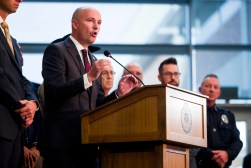Technology to play pivotal role in new ‘transformation’ plan pitched by Arkansas Gov. Asa Hutchinson

Last week, Arkansas Gov. Asa Hutchinson unveiled new details showing what his plan for “transforming” state government will look like. A new departmental structure showcased by the Republican, who is seeking reelection next month, would reduce 42 executive-level departments to just 15, and place the state’s technology offices in a new department that would play a central role in the transformation effort.
In reducing the number of direct lines to the governor’s office, Hutchinson paints the reorganization as a “long overdue” pursuit of modern government operations and service delivery. By placing existing departments, boards and commissions with similar functions into larger departments, the governor expects a gradual transition toward efficiency and shared services that will begin to yield financial benefits starting in fiscal year 2021.
While eliminating redundant government functions — and by extension, employees — is a central piece of the plan, the governor says all of this is to happen without laying off any employees, instead reducing the state’s workforce naturally. This attrition has already begun, according to Hutchinson’s office, with the state has reduced its payroll by 1,500 jobs over the last three years by simply not filling vacancies left by retirements and resignations.
The grand transformation plan still requires legislative approval, though. Hutchinson is now working with two Republican legislators, State Sen. Bart Hester and State Rep. Andy Davis, to draft legislation for the 2019 session.
If approved, the plan would create a new Department of Transformation and Shared Services, which would be charged with leading management control and streamlining operations throughout state government. This department would combine the Department of Information Systems, Arkansas’ information technology agency, with the state’s Geographic Information Systems office, Office of Personnel Management, Office of Procurement, Office of Transformation, Division of Building Authority and the Employee Benefits Division.
One potential choice to oversee the proposed department is Amy Fecher, currently the state’s chief transformation officer and executive vice president of operations for the Arkansas Economic Development Commission. Fecher emphasized to StateScoop that while this transformation effort isn’t expected to bring any immediate changes, the long-term effects could be highly influential in how the state works.
“Many of your state agencies are operating very independently and very siloed,” she said.
When asked for examples of existing transformation projects underway in the state, Fecher pointed to an electronic procurement upgrade now underway in the Department of Finance and another project to make the state’s public safety radio towers interoperable across many agencies. The launch of a new functionality in March that allows residents to apply for vehicle registration and other services online, Fecher said, is one kind of public benefit people can expect to accrue from this transformation effort.
Technology is expected to play a pivotal role in the transformation, explaining the inclusion of DIS in the new transformation department. DIS Director Yessica Jones said her employees are excited about the prospect of combining with other agencies, a process that she says would support the foundational work already underway.
DIS’ two biggest projects today include a hybrid-cloud data center optimization that is expected to save the state between $4 million and $5.4 million annually, and a migration to Microsoft Office 365. A key component of upgrades like these is standardizing infrastructure and solutions across agencies, Jones said. A new departmental structure that places the technology office as an orchestrating member of this effort could allow more of those kinds of standardizations to be realized.
“It’s going to give us more leverage,” Jones said. “If you think about it this way, we are part of the shared services department, so what we are currently doing is going to impact everybody.”
The transformation would likely have widespread effects both inside state government and throughout the state at large. Jones said Arkansas is one of just six states that haven’t consolidated their information technology functions, but that an overhaul of state government would be a big step toward statewide infrastructure consolidation.
According to a poll taken last month, Hutchinson currently leads his Democratic opponent, Jared Henderson, by 35 percentage points. Henderson has criticized the governor’s transformation plan as an outdated political discussion of “bigger government versus smaller government rather than tackling our state’s most critical problems.”
But Hutchinson’s effort is not the first of its kind in Arkansas, where the number of statewide agencies has been historically elastic. In 1972, then-Gov. Dale Bumpers consolidated 60 departments into 13. Former Gov. Mike Huckabee, who was in office from 1996 to 2007, attempted to shrink 53 agencies to just 10, but failed to overcome political opposition. Huckabee did succeed in combining the Department of Human Services with the Department of Health, creating the Arkansas Department of Health and Human Services, but that change was eventually reversed by his successor, Democrat Mike Beebe.






